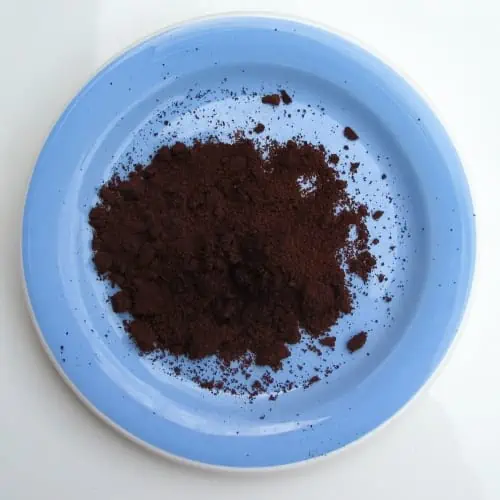
Highly valued for their richness in caffeine and for the delectable flavor they impart to beverages, coffee grounds have become a home staple all over the world. Who would’ve thought that this gift from nature, though initially bitter and highly acidic, would benefit plants too? Rich in nitrogen, potassium, and phosphorus, coffee grounds contain many of the essential nutrients required for plant growth and survival.
Lauded as an organic ingredient for compost, a mulch additive, and as a potential alternative to chemical fertilizers, coffee grounds may be a safe form of plant food for acid-loving species. Some horticulturists may warn against using fresh or unbrewed grounds, which contain more caffeine and acid. Used coffee grounds pulled straight from the filter of a coffee maker, however, will have lost some of their strength and should be less harmful.
Coffee grounds can be raked into the substrate or into compost (including vermicompost) to increase porousness and lower pH levels. As they organically enrich the soil, they also help repel troublesome insects and snails.
While grounds are a rich and natural source of nutrients, keep in mind that the roots of some acid-sensitive plants (e.g. lavender, tomatoes, rosemary) may not be able to tolerate exposure. Moreover, in substrates that are already rich in nitrogen, the added nutrients may stunt plant growth. Coffee grounds are thus best used in nutrient-poor soils and for plants that thrive best in slightly acidic conditions.
Plants That Love Coffee
1) Hortensia (Hydrangea spp.)

One of the most fascinating things about hortensias is the color variability of their charming blooms. Dependent on the soil’s pH and its richness in aluminum ions, the bloom color varies from blue to pink to red. If the soil is slightly acidic (pH < 7), the inflorescences are more likely to be blue or purple. Inversely, if the soil is slightly basic, the flowers are increasingly pink.
If you find that your hortensias produce pink blooms, you may experiment with altering the colors of new blooms by introducing coffee grounds into the soil. The coffee grounds, which are acidic, are likely to lower your substrate’s pH, inducing the production of blue blooms. For this to work, aluminum ions need to be present in the soil as well. Note that some Hydrangea cultivars and species are more likely to produce blue pigments than others.
The most popular ornamental species in this group of plants include H. macrophylla, H. paniculata, and H. serrata. Coffee grounds are best added to the substrate around the base of well-established Hydrangea species in late fall. Aim to introduce grounds up to just 3 times a year to avoid shocking the roots of the plant and causing stunted growth. To prevent the surrounding area from smelling too much like coffee, thoroughly work the grounds into the soil.
2) Azalea (Rhododendron spp.)

Frequent favorites in lush gardens with flowering shrubs, azaleas are stunning ornamental plants with an array of bloom colors. In spring, the brilliantly colored inflorescences can dramatically change the appearance of these shrubs, causing them to look like large bouquets. The best flowering rates are usually observed in areas with woodland conditions, slightly acidic or humus-rich substrates, and partial or dappled shade.
Depending on the species and where they are grown, azaleas may be deciduous or evergreen. Even in optimal conditions, some of them are known for being quite slow-growing and sensitive to pests and diseases. Regardless, carefully cultivating them is usually worth it for their long-lived blooms. Able to last up to several weeks long, the blooms tend to produce a highly toxic and potentially medicinal nectar.
If you intend to fertilize your azaleas with coffee grounds, keep in mind that they are not necessarily heavy feeders. Application of grounds into the soil around the plant should serve the purpose of lowering pH levels to its preferred values (around 4.5 – 6) for good growth. The grounds should ideally be introduced in mulch or compost and they should not be pressed onto the plant itself.
3) Highbush blueberries (Vaccinium sect. Cyanococcus)

Cultivated blueberry shrubs usually fall under the classification of highbush blueberries. The most popular species, which is grown for ornamental purposes and for its economically important fruit, is the northern highbush blueberry (V. corymbosum). Compared to wild blueberries, this species produces larger fruits and can grow up to 3.7 meters (12 feet) tall in optimal conditions.
To grow healthy specimens of highbush blueberries, the substrate’s pH needs to be markedly acidic. These plants favor pH levels along the range of 4.8 – 5.2, which is why coffee grounds may be effective as a soil additive. To fertilize blueberry bushes, make sure to work the grounds into the top few inches of soil. This way, they can break down at a faster rate and are less likely to affect the growth of any sensitive plants nearby.
Apart from lowering pH levels, coffee grounds should provide blueberry shrubs with the nutrients they need to produce fruits. Nitrogen, potassium, phosphorus, magnesium, calcium, and copper are some of the elements required for proper fruit development. Some horticulturists may warn against using grounds due to their caffeine content. If you’re concerned about the traces of caffeine stunting fruit growth, you can add the grounds to compost first and then apply the compost around the shrubs.
4) Lily of the valley (Convallaria majalis)

An herbaceous perennial with lovely ornamental features, lily of the valley is known for its bell-shaped blooms and alluring odor. This species’ scent, which is considered a classic fragrance, has inspired some of the world’s most famous perfumes. Once the national flower of both Yugoslavia and Finland, this flowering plant comes in many cultivars that have received the RHS Award of Garden Merit.
As C. majalis is a mesophile, it favors mild climates and usually thrives best in partial shade. Although it is usually advisable to grow this species in slightly alkaline substrates, it is able to tolerate mildly acidic soil. Old or used coffee grounds, which should have a lower acidity profile compared to freshly ground coffee, are the more appropriate choice for providing nutrients to its delicate roots.
It’s important to note that lily of the valley is a highly toxic species that may cause undesirable symptoms when ingested by animals or humans. The plant, including its berries, contains dozens of cardiac glycosides. Make sure it is grown in areas that are difficult for children or pets to access.
5) Carrot (Daucus carota subsp. sativus)
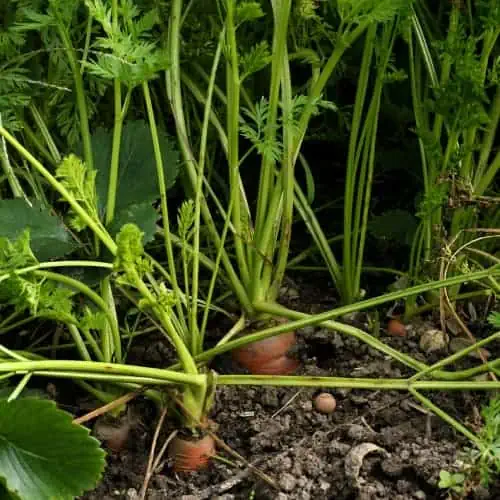
Known best for its specialized taproot, for which it is selectively bred and cultivated across the globe, the humble carrot is a biennial vegetable with a rich nutritional profile. Its fast-growing cultivars get their vivid orange coloration from a combination of carotenes, which are metabolically converted into vitamin A. Carrots also have high amounts of vitamin K, vitamin B, and free sugars.
Most types of carrots thrive best in soil with slightly acidic to neutral pH levels. For their taproot to grow into a favorable shape and produce a high ratio of cortex to core, they should be situated in sandy loam. Heavier soils are only tolerated if they do not hinder drainage. Used coffee grounds can be thoroughly worked into patches of soil where you intend to germinate your carrots.
Coffee grounds should provide the seeds and seedlings with a boost of nutrients to stimulate plant growth from the point of germination. While improving harvest rates, the slightly acidic grounds should also dissuade pests from coming too close to your growing carrots! Cultivating other acid-loving companion plants should also help these root crops thrive.
6) Radish (Raphanus raphanistrum subsp. sativus)
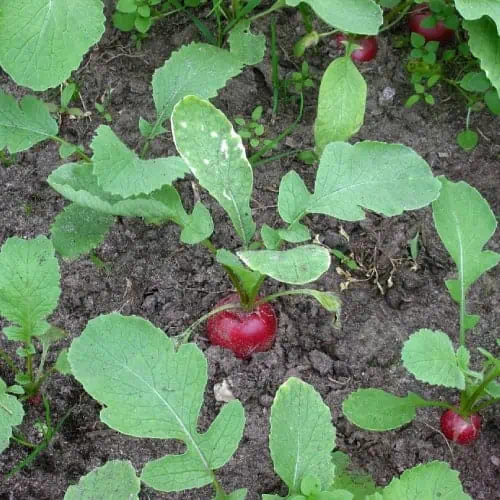
Producing red, white, or greenish brown globes of globular to cylindrical taproots, radishes are rapidly growing annuals. Known for their unique flavor in cooked dishes and for their sharp taste in salads, they come in many varieties that are extremely important in East to South Asian cuisine. Often mistaken as turnips or parsnips by the untrained eye, radishes can easily be grown in home-based vegetable gardens.
Radishes thrive best in regions with moderately warm temperatures. In areas with markedly cool or intensely warm temperatures (> 25˚C or > 77˚F), the crop may take several weeks longer to mature and reach harvest size. The best conditions for the growth of the taproot include a loamy substrate, full sun exposure, and a slightly acidic to neutral pH level. Just as coffee grounds can increase harvest rates and speed up germination for carrots, they should promote the growth of radish seedlings.
Radishes can thus be germinated and grown alongside carrots, in the same substrate where used coffee grounds or coffee-rich compost is worked into. Coffee grounds slowly release nitrogen, so they are able to provide a stable supply of this nutrient for at least the first few days to weeks of radish growth.
7) Roses (Rosa spp.)
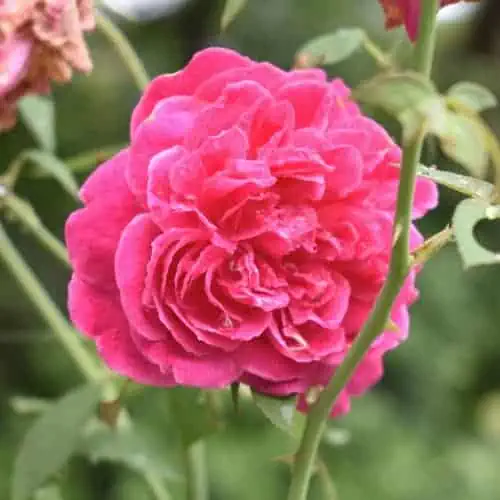
With flowers that are unrivaled in their popularity, roses are cultivated almost everywhere. These ornamental plants are used for many purposes, ranging from decorative and artistic to medicinal and aromatic. There are more than a hundred rose cultivars that have received the RHS Award of Garden Merit. Some of the most commonly cultivated types include English roses, tea roses, and wild roses.
Many Rosa varieties may benefit from fertilization with coffee grounds as they favor substrates that are rich in organic matter. The nutrients provided by the grounds can help improve the general quality of the soil as well as fortify and hasten the growth of the plant. When used in moderate amounts, they also optimize the substrate’s acidity profile and attract beneficial worms.
If you intend to fertilize your roses with coffee grounds, aim to do so at the beginning of their peak growth period (spring). Avoid adding the grounds past fall as they can damage roses that are about to become dormant. You can either sprinkle the grounds directly on the substrate around the rose bushes (watering them afterward to help distribute their nutrients) or you can mix them into a water solution beforehand.
8) Philodendron (Philodendron spp.)
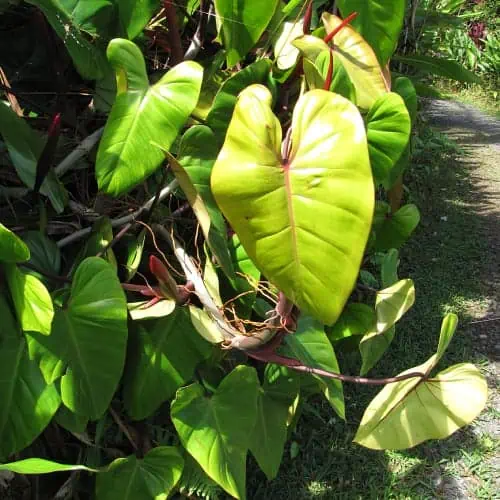
Known for their stunning leaves, which can grow to enormous sizes, philodendrons are some of the most popular houseplants. Healthy specimens favor mild temperatures and are able to thrive in shady areas. They are fairly easy to grow and can be propagated using the stem cuttings of mature plants. As a result, their colonies have become naturalized in many countries outside of their native range.
Capable of growing in an epiphytic or terrestrial manner, philodendrons send out sturdy roots that tend to grow toward soils with their favored conditions. They prefer slightly acidic pH levels ranging from 6.0 – 6.5. As a result, coffee grounds can be used as a natural source of required nutrients for growth. However, you’ll need to make sure that the soil pH is close to neutral prior to introducing the acidic grounds.
When used in the right concentrations and applied at the proper time, coffee grounds can significantly aid in boosting the health of nutrient-deficient philodendrons. They can be introduced into the substrate of mature plants as part of compost or as liquid fertilizer (such as compost tea).
9) Camellia (Camellia spp.)
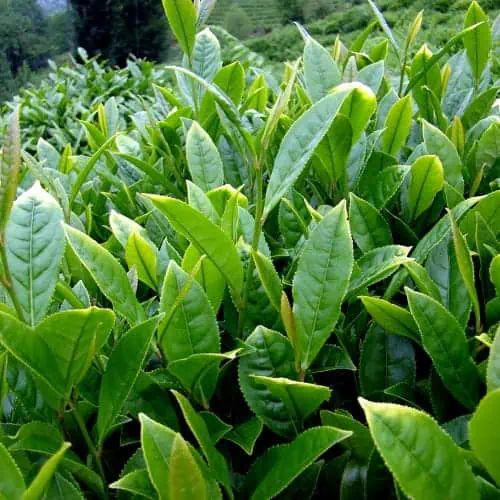
With hundreds of species and thousands of hybrids, Camellia is a diverse genus of flowering shrubs and trees. Evergreen in their native range, these glossy-leafed plants favor naturally irrigated substrates with acidic conditions. Those grown in gardens and for commercial purposes, including the famous tea camellia (C. sinensis), tend to have a rapid growth rate and produce eye-catching blooms.
As they are well-adapted to acid-rich soils, camellias can thrive in substrates that are amended with coffee grounds. The nitrogen from the grounds can aid in optimal leaf growth, while the leached phosphorus promotes flower and fruit production. The aroma of coffee should help prevent pests from attacking the shrubs.
Coffee grounds can be introduced to the substrate around the base of camellia shrubs in various ways. The simplest way is done by simply sprinkling the grounds onto the surface and using a rake or shovel to work them through the top few inches. Avoid leaving the grounds on top of the substrate as they can form a layer that dries out and repels water, preventing it from draining evenly through the substrate.
10) Gooseberries (Ribes spp.)
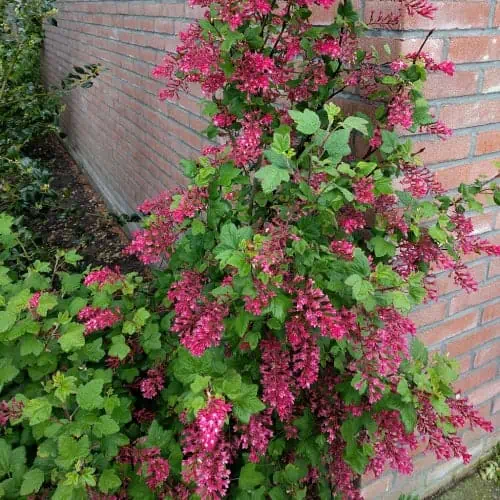
Gooseberries, or currants, are cultivated for their fruits and for their ornamental features. Shrublike, these plants favor environmental conditions in areas that are close to streams or in regularly moistened meadows. Many species are favored by larvae as a source of food. Their berries, many of which are edible for humans (e.g. white currant, blackcurrant, red currant), usually appear from June to July.
As gooseberry bushes favor slightly acidic soil conditions, coffee grounds may be used as a fertilizer and as a natural means of reducing pH levels in alkaline substrates. The grounds should be mixed into compost first so that they are less likely to scorch the roots of the bushes and inhibit fruit growth. The nutrient-rich compost can then be incorporated into the soil around the base of the bushes.
One of the most common gooseberry species in cultivation is R. sanguineum. Although this species is native to western North America, it is quite popular among horticulturists in the UK. Valued for its sweetly scented and delicate inflorescences, it can vegetatively reproduce to form dense stands in moist soils. Occasional fertilization with a coffee-filled compost should help increase rates of flower and fruit production.
11) African violets (Streptocarpus spp.)
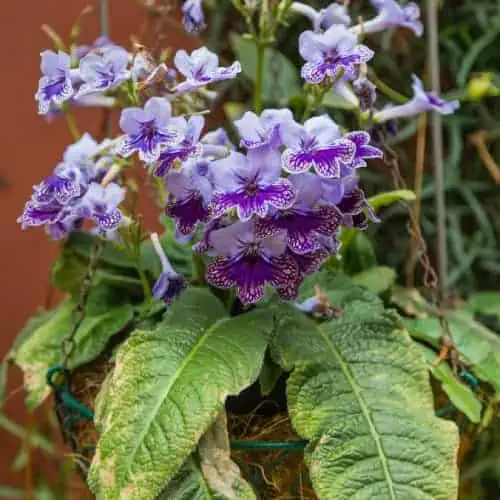
Also referred to as saintpaulias, African violets belong to a small group of about 6 – 10 flowering herbs. Well-loved in cultivation for their fascinating leaves and vivid flowers, they are often grown as indoor plants. In the wild, many of their populations are threatened or endangered due to the conversion of land into agricultural zones. Thriving best in cloud forests, which are tree-rich biomes with low-level cloud cover, they are sensitive to temperature and moisture fluctuations.
During the growth period of African violets, they may be fertilized with coffee grounds. Sprinkling used grounds into the surrounding substrate should help release nitrogen and create slightly acidic conditions, which may improve foliar health. These plants thrive best in soils with a pH range of 5.8 – 6.2, so the grounds can be used to amend regular potting mixes with a neutral pH level.
Coffee grounds should only be introduced into the soil if you haven’t fertilized the plant beforehand. While it should not necessarily take the place of a balanced, store-bought fertilizer, its addition on top of one may not do African violets any good. If you do opt to use grounds, apply them with a light hand or mix them into compost beforehand.
12) Jade plant (Crassula ovata)
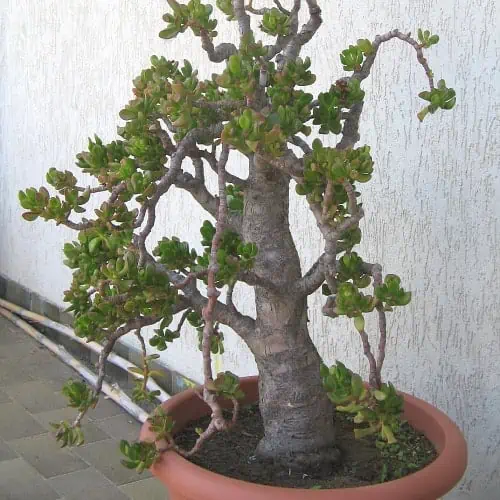
One of the most commonly grown succulents in indoor locations, the jade plant or money tree is believed to impart luck. For ornamental purposes, it can be grown as a bonsai of sorts; its basal stems expand when its branches are carefully pruned. Distinguished by smooth, shiny, and fleshy leaves, it now comes in remarkably colorful hybrids with varied leaf shapes.
As jade plant favors slightly acidic soil, it can benefit from being fertilized with coffee grounds. Alkaline soil may adversely affect its health, so the grounds can also be used to lower the substrate’s pH in pots that are prepared for cuttings and for repotting older specimens. It can even be watered with diluted cold-brewed coffee. The added nutrients should help enhance the color of the leaves and aid in shoot reinforcement.
When using coffee grounds for your jade plants, make sure the particles have not been exposed to milk, sugar, cream, or syrup. The grounds should ideally be black and pure so that they don’t inadvertently attract pests. When providing the coffee as a compost tea, thoroughly dilute at least 2 cups of the grounds in 5 gallons of water. The soil’s pH levels should be checked beforehand to ensure that the coffee doesn’t bring an already low pH level to potentially lethal values.
13) Meyer lemon tree (Citrus x meyeri)
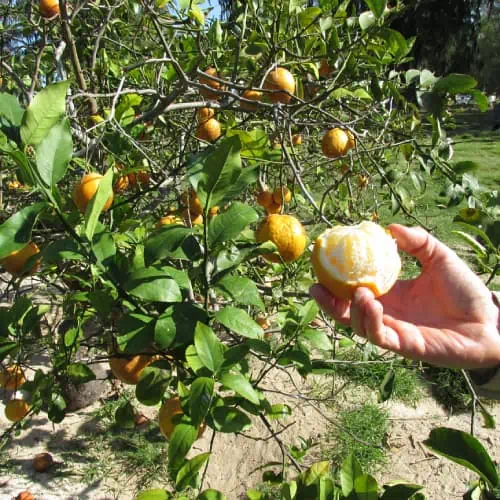
Frequently dubbed the “world’s best lemon”, the fruit of the C. x meyeri tree is the result of a cross between two citrus plants. Though it has the familiar color and shape of a lemon, isn’t actually a true lemon because it contains genes from mandarin, pomelo, and citron varieties. Once this wholly edible fruit – skin and all – has ripened, it sports a faintly orange tone and produces a sweet albeit slightly acidic juice. Its unripe fruits are more starkly acidic, with pH levels ranging from 2 – 3.
The Meyer lemon tree grows to a full height of about 10 feet (3 meters). This ornamental citrus variety produces glossy, deep green leaves that thrive best under direct morning sun and light afternoon shade. In warm climates, it maintains an impressively hardy profile and may seem to grow all throughout the year. If you find that its growth rate falls short of expectations, you might consider fertilizing its soil with coffee-infused compost.
Coffee grounds are known for being quite beneficial for lemon trees, but they are often used in the wrong way. Some gardeners may report unfavorable results if they apply the used grounds directly, as a thick layer, to the topsoil around young trees. Though well-established Meyer lemon trees may tolerate an increased concentration of caffeine and nutrients in the soil, allowing the grounds to break down in compost prior to usage is highly recommended.
14) Thanksgiving cactus (Schlumbergera truncata)
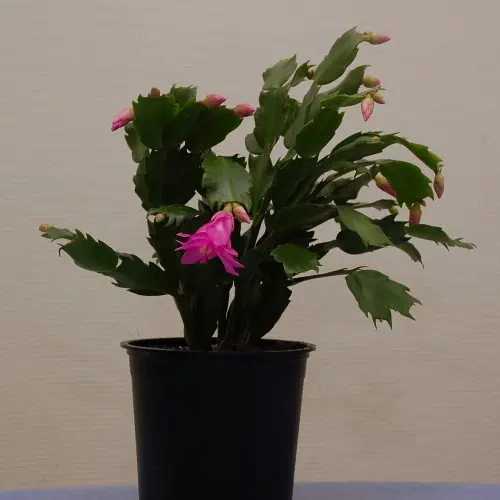
The Thanksgiving or “False Christmas” cactus benefits from fertilizer just before its peak bloom period. This stunning epiphytic succulent hails from habitats that may have pockets of highly acidic conditions and rich concentrations of nutrients. This is why it is more likely than other plants to perk up once its roots are able to access more nitrogen, potassium, magnesium, and moisture with slightly acidic pH levels.
Set apart by its modified stems, which are segmented into flattened internodes (scientifically known as ‘phylloclades’) with serrated margins, the Thanksgiving cactus is most productive at around 68˚F (20˚C). Before using coffee grounds to encourage flower production, make sure that your holiday cactus is actually being kept in optimal conditions. If temperatures are too high or low, adding nutrients and increasing soil acidity will not necessarily result in more blooms and may be more detrimental to your plant.
Used coffee grounds should not be sprinkled directly into your pots of Thanksgiving cactus. Instead, dilute the grounds in water and remove them after a quick steeping period. You may dilute the water further if you are wary about its effects on the plant. When watering your plant with a coffee-infused solution, make sure excess moisture can escape through the pot’s holes.
15) Snake plant (Dracaena trifasciata)
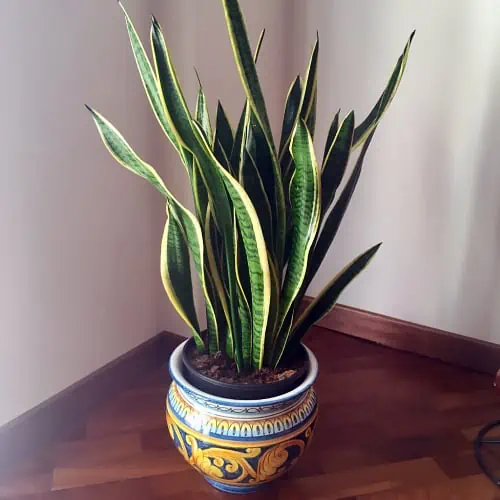
The humble snake plant has become one of the most commonly grown houseplants in tropical to temperate regions. This hardy perennial produces stiff, lengthy leaves with a tapered, tongue-like shape. These emerge from self-spreading rhizomes located below or just above the soil’s surface. The roots are able to thrive in poor substrates with minimal or irregular moisture input.
The snake plant’s remarkable tolerance for dry conditions and its preference for being rootbound make it one of the least needy ornamental plants around. Prolonged growth in low-nutrient soils, however, can cause its leaves to lose their stiffness. Nutrient deficiency may also cause them to grow dull and turn yellow. Compost, mulch, or an organic fertilizer infused with nutrients from used coffee grounds may help them grow with renewed vigor.
Composted, used coffee grounds can also be mixed into a potting substrate for transplanting mature or nutrient-deprived specimens. Make sure to use conservative amounts and simply observe how the leaves respond to the added nutrients. If they continue to develop abnormally pale margins or begin to die back, note that adding more nutrients may not be a solution to the problem.
16) Gardenia (Gardenia spp.)
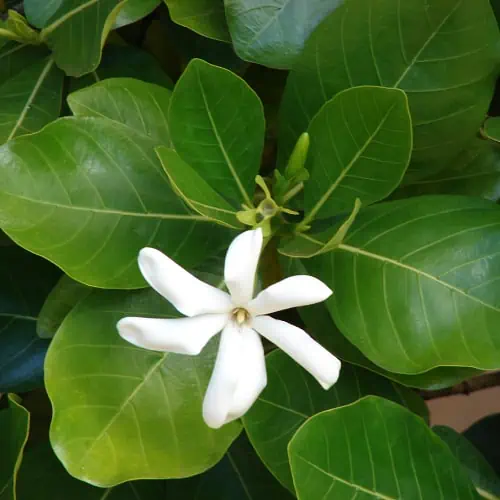
As gardenias are actually members of the Rubiaceae or coffee family, it’s not surprising that they respond quite well to being fertilized with used coffee grounds. These flowering ornamentals may grow as resplendent shrubs or as decorative small trees. They usually produce fragrant blooms with cream-toned pigments in mid-spring to summer. Their leathery leaves are evergreen and glossy, and may measure as much as 20 inches (51 cm) long!
Though they are common as garden plants in humid regions, gardenias can be quite challenging to cultivate. Their culture preferences may differ according to species, with some preferring full sun and others thriving more in light shade. In summer, even well-established specimens may lose some leaves due to scorching from direct sun and low moisture levels. Maintaining an organic mulch above the topsoil should help keep the crown and roots in good shape.
As gardenias favor slightly acidic pH levels, a liquid fertilizer infused with used coffee grounds can be used. To wash away excess nutrients, potentially high concentrations of caffeine, or other unwanted compounds, you may use distilled water or rainwater.
17) Sago palm (Cycas revoluta)
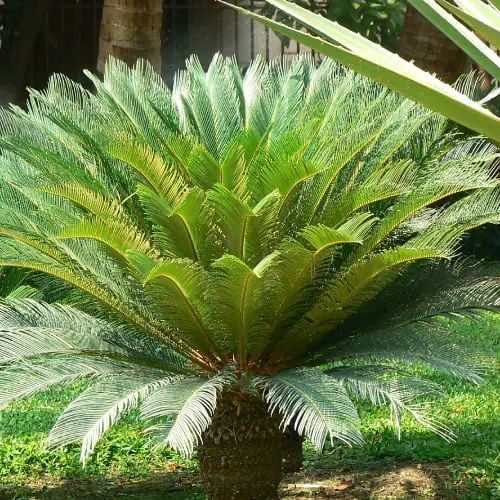
The sago palm is a notable member of the Cycadaceae family, which has a general morphology that’s been conserved for more than 100 million years. Among species grouped under Cycas, it has the most widespread range as an introduced plant. Despite its common name, it isn’t actually a true palm. Its fronds simply resemble the appearance of those on miniature palm trees.
Like most cycads, the sago palm favors soil pH levels that range from 5.5 – 6.5. It also appreciates well-timed boosts of nitrogen and potassium. Some gardeners swear by the benefits coffee grounds may impart to actively growing sago palms. To provide conservative doses of nutrients, it would be best to use grounds that have been broken down (in compost) or diluted in water.
Heavily sprinkling coffee grounds directly around the plant may adversely affect the roots – especially if they are restricted to within a container. Instead, the grounds may be provided as a component of organic mulch in response to yellowing leaves or just before the peak growth season of the plant.
18) Potatoes (Solanum tuberosum)
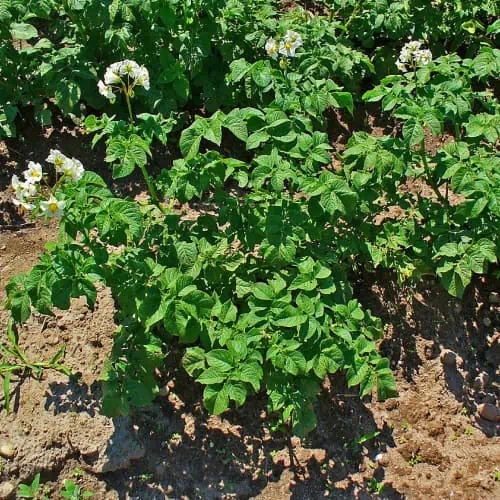
With a little dedication, even inexperienced gardeners may successfully cultivate a bounty of potatoes in a home garden. This versatile, starch-rich tuber now comes in dozens of domesticated varieties with slight variations in flavor, color, growth rate, and environmental preferences. Generally, however, they prefer nutrient-rich substrates with a porous composition. Good drainage is crucial for keeping the tubers disease-free.
Ideally, potatoes should be cultivated in soils with slightly acidic pH levels. They can tolerate levels that go down to 5 but tend to grow best at a pH of 6 – 6.5. A high-quality potting compost should provide the roots with all of their required nutrients. A homemade one should work great too as long as it is well-balanced and loamy. A potato trench could be topped with about 2 – 3 inches (5.1 – 7.6 cm) of organic compost.
Though a store-bought compost would perhaps be your safest option, don’t shy away from incorporating used coffee grounds. These should help improve the quality of the soil, especially if it tends to be nutrient-poor. While coffee grounds, on their own, are seldom able to significantly bring down pH levels in alkaline soils, it definitely won’t hurt to use them as a slow-release source of nitrogen in calcareous locations.
19) Peace lily (Spathiphyllum spp.)

The leached nutrients from coffee grounds are excellent for peace lilies grown in indoor and outdoor locations. Typically found in the understories of rainforests, peace lilies have evolved to thrive best in slightly acidic habitats with rich nutrient profiles. These tropical perennials have become incredibly popular as ornamentals due to their large, evergreen foliage and their milky white to green spathes.
Peace lilies grow as clumps with their upright foliage and floral stalks emerging through the soil’s surface. For this reason, the base of the plant can be quite sensitive to topsoil composition as well as any additives placed directly on the soil surface. To prevent leaf yellowing and leaf rot, it would be best to incorporate coffee grounds via a low-strength mixture. Testing the soil’s pH is also recommended beforehand as adding acidic compounds to an initially acidic substrate may backfire.
20) Pothosa (Epipremnum aureum)

Another remarkably popular and hardy indoor plant, pothos is one of the best species for inexperienced gardeners. This fast-growing creeper can be grown as a ground cover plant as its trailing stems send out roots wherever they come into contact with soil. It can also be trained to climb vertical structures, like fences and trees. In indoor settings, it is often placed in hanging or elevated containers, from which its stems may cascade in search of surfaces to cling to.
Capable of reaching lengths of up to 40 feet (12 meters), pothos or “devil’s ivy” thrives in organically enriched environments with indirect light. This robust perennial loves humid conditions and benefits from being fertilized. Its mature leaves can grow quite large in optimal conditions. The macro and micronutrients in used coffee grounds can give them a much-needed boost, allowing them to develop at an impressively quick pace.
While some gardeners in tropical regions may simply dump used coffee grounds in areas where pothos can effortlessly grow, you’ll want to use them in much more conservative doses for mature, indoor specimens. Working handfuls of used grounds into the topsoil may shock the roots, so it would be best to introduce their nutrients via a porous, coffee-based compost. This can be used just once every 10 – 12 weeks during the pothos’ peak growth period.


Learned alot about coffee grounds and plants Thank you
That’s great to hear, Linda! Thank you for commenting, and happy gardening.
I’ve used coffee grounds that were used then dried for Azaleas and roses and did not know I could use on other plants. Thanks for all the useful information.
Thank you
Very informative. Thanks
Glad you found the article helpful, both! Do let us know if you have any related questions.
Does it have to be used coffee grinds.? We use instant coffee but when coffee is on sale, I’ll buy a can and mix it in 1/2 gal bottle and feed plants with that. Is that ok?
Yes thank you 😊 x
Glad we could help, Donia.😄
My Meyer lemon bus h has really benefited from coffee grounds. More blossoms, more fruit, greener leaves. Much healthier!
How did use coffee grounds on the Meyers Lemon plants?
Thanks for including me!
Meyer’s are the Cadillac of lemons, in my opinion. My grandma had two trees, my mom one, and lemon juice was available all year long. In addition to coffee grounds, they both added the ashes from the fire pit to the soil. My mom planted her tree in 1949 and it’s still producing a good mount of lemons.
Hi Donna,
I agree with you that Meyer lemons are the best. They have a sweeter and more complex flavor than regular lemons, and they are very versatile, too! Thank you for sharing your experience and tips with us.
Hi Chris, I just found you site and like it a lot!
Question; can Myers Lemon trees be grown inside the house? Or, is their a spiecies you could recommend. I’m in Iowa and we had -9 for the high today…probably no good for lemony Meyers!
Thank you,
Peggy
Thanks for sharing, Marjorie! Very interesting. We’ll look into the plant and maybe add to our list. Glad to hear it’s so happy and healthy!
Great advice!! Thank you 😊
Glad you enjoyed the content, Evelynn. Thanks for commenting! 🙂
Will try on my philodendron
Best of luck, Judith! Do report back and let us know how things go. 😄
Found the article very interesting and good advice to be used world wide!
Cheers, Nick! We really appreciate the kind words. Glad to hear you found it helpful.
I have acquired an elephant plant from the stems of a plant,I have added lots of coffee grounds after putting the leaves in dirt, and it has grown from two leaves to four in about two weeks. I have also used the Banana,soybean, And more, but am very happy with the results! THANK YOU 🙏
Does anyone know if coffee grounds will work on a Thanksgiving cactus?
Mix a tbsp of use coffee grounds in a gallon of water about bloom time. Water with it once or seven days later, creating more blooms.
Thanks for helping out and sharing your knowledge, Joyce! Very useful advice.
That’s great to hear, Estel. Thanks for sharing! We always love hearing readers experiences with coffee grounds as I’m sure there are loads of plants that benefit which we’ve yet to cover. I’ll need to try some grounds on our elephant plant now! 😁
Does this also apply to the use of decaf coffee?
Hi Diana. Although some decaffeination processes can alter the pH of coffee a little, I’d say decaf is still fine to use as the change will be very small. Decaf should work just as well for the vast majority of plants!
I have heard that Snake plants like coffee grinds as well.
Yes. I had a snake plant that was limp. I put coffee grounds in the pot and now it’s back to standing straight up.
Thanks for sharing, Richard. I’m glad your snake plant managed to perk up!
Thanks for the question, Meredith. Yes, snake plants can benefit from coffee grounds in moderation. Just use a little at a time and see how your plant responds.
Going to try on my roses!
Thank you!
I am planting some pototas , do pototas like coffee grounds
Very helpful. Going to try on our hydrangeas. Thank you.
How do you use grounds on lemon or potted citrus ie lemon plants?
Thank you for the article
Heidi
Very informative! I loved this article ❤️
If using coffee grounds on potted plants how much do you use?
If using on plants outdoors, how much?
Do bamboo plants like coffee grounds? Like this article very much. Very informative. Thanks chris
I am a firm believer that coffee grounds have many uses. I have always put them in my compost pile. Them recycle the plastic pods
I will have to put some on my philodendrons. It like my west window but one time my husband moved it and I almost lost it. So she is back where she belongs and doing better. But I cut the vines off and share them with people. I love sharing.
Thanks for you article.
Super useful info thank you
Thanks for the article. I empty my cafetière onto some part of the garden every morning when the coffee is all gone. I fill the pot with cold water and in the summer, pop out to a different part of the garden each day, and simply throw the whole lot onto the soil. I must admit it hadn’t occurred to me that some plants might like it more than others. So after reading the article I will try to be more selective with my throwing ! In the winter it goes into the compost though. Too cold to be trotting around the garden first thing.
Do crown of thorns,and prayerplants enjoy coffee grounds?
Hi Patricia,
Thank you for your comment! Crown of thorns and prayer plants are both sensitive to over-fertilization, so coffee grounds may not be the best option for them. Coffee grounds are acidic and high in nitrogen, which can cause leaf burn and stunt growth in some plants. A better alternative would be to use a balanced, organic fertilizer that is diluted to half-strength and applied once a month during the growing season. I hope this helps!
So interesting. I usually don’t read articles this, was so damn easy and interesting I could not resist.
That’s awesome, Jimmy! Thanks for your kind words. We are really happy to hear that. Our team always trys to make articles detailed but also digestible, as it doesn’t help anyone if the content puts readers to sleep haha.
Very informative. I gave it to my potted roses, blooms a lot & agapanthus & ground succulents. So far so good. I’ll try it on Hoyas & African violets , they’re outdoors. Thank you ❤️❤️
Hi Ana,
I’m really glad you found the article helpful. It sounds like you have a lovely garden! I hope the grounds work well for your Hoyas and African violets too. Thank you for sharing your experience with us.
Thank you. Very informative.
Thanks for commenting, Doris! Very glad to hear you found the article helpful.
Brilliant information i shall try on my roses also radishes which have been very poor this year .
Thank you .
Hi Cheeks,
I’m glad you found the information useful! Roses and radishes are both plants that often benefit from some extra care, and tend to do well with coffee grounds especially. I hope you have a successful gardening season!
Love your platform of info & comments very informative & great reminders direct & to the point.
Much appreciated,
Ty,
Rose in Bedford, Nh
Hi Rose,
Thank you for your kind words! We’re super happy to hear you’re finding the information useful.
I was wondering too. I’m going to feed my Jade plant and why not, I don’t think once will hurt on my Thanksgiving catus.
We have updated the article and expanded our list of plants that love coffee grounds! Thanks to all our readers for sharing their experiences and suggestions. Some of your picks have made the list, too!
Thank you Chris for all the info I live in Northern oCalifornia and I’m going to start using coffee grains in my soil for my plants come March
Would tea leaves have the same effect as coffee grounds?
Hi Mary,
We have a separate article here with information on the benefits of tea for plants and some plant species we recommend: https://pondinformer.com/plants-that-like-tea/